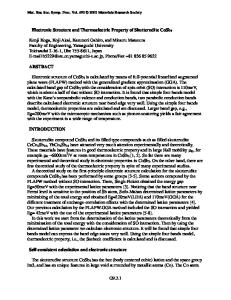Pulsed laser deposition and thermoelectric properties of In- and Yb-doped CoSb 3 skutterudite thin films
- PDF / 633,105 Bytes
- 6 Pages / 584.957 x 782.986 pts Page_size
- 93 Downloads / 390 Views
A. Alyamani Nanotechnology Centre, King Abdul Aziz City for Science and Technology, Riyadh 11442, Saudi Arabia
J.W. Graff and T.M. Tritta) Department of Physics and Astronomy, Clemson University, South Carolina 29634
H.N. Alshareef b) Materials Science and Engineering, King Abdullah University of Science and Technology, Thuwal 23955-6900, Saudi Arabia (Received 10 April 2011; accepted 1 June 2011)
In- and Yb-doped CoSb3 thin films were prepared by pulsed laser deposition. Process optimization studies revealed that a very narrow process window exists for the growth of single-phase skutterudite films. The electrical conductivity and Seebeck coefficient measured in the temperature range 300–700 K revealed an irreversible change on the first heating cycle in argon ambient, which is attributed to the enhanced surface roughness of the films or trace secondary phases. A power factor of 0.68 W m 1 K 1 was obtained at ;700 K, which is nearly six times lower than that of bulk samples. This difference is attributed to grain boundary scattering that causes a drop in film conductivity.
I. INTRODUCTION
This author was an editor of this focus issue during the review and decision stage. For JMR policy on review and publication of manuscripts authored by editors please refer to http://www. mrs.org/jmr-editor-manuscripts/ b) Address all correspondence to this author. e-mail: [email protected] DOI: 10.1557/jmr.2011.198
a benchmark criterion for effective conversion of thermal energy into electricity.8,9,11 Recently, there has been some debate as to whether In occupies the cages as a rattler atom or dopes with Sb in the system.12 Further reduction in thermal conductivity is possible by preparing skutterudites in the form of low-dimensional systems such as thin films.13,14 The presence of grains and grain boundaries in thin films can serve as additional scattering centers and help reduce the thermal conductivity. However, skutterudite thin films have been reported to have inferior power factor (S2rT ) compared with their bulk counterparts, negating the possible improvement of ZT by the reduction of thermal conductivity.13,15,16 The difference in behavior of the material in bulk and thin film forms is believed to be the major reason behind the failure of efforts to enhance ZT. Furthermore, skutterudite films have a very narrow range of stability, and deviations from the optimal deposition conditions result in off-stoichiometric or multiphase regions resulting in deterioration of the thermoelectric properties.17 Direct current (dc) and radio-frequency (rf ) magnetron sputtering,16,18–20 co-evaporation of constituent elements,21–23 and pulsed laser deposition (PLD)13,15,17,24,25 are the three prominent methods reported for the growth of skutterudite films. Though CoSb3 films have been explored in much detail in previous works, filled CoSb3 thin films have not been extensively studied. A better understanding of the structure–property relations in doped CoSb3 thin films is valuable for the realization of high-efficiency
1836
Ó Materials Res
Data Loading...











